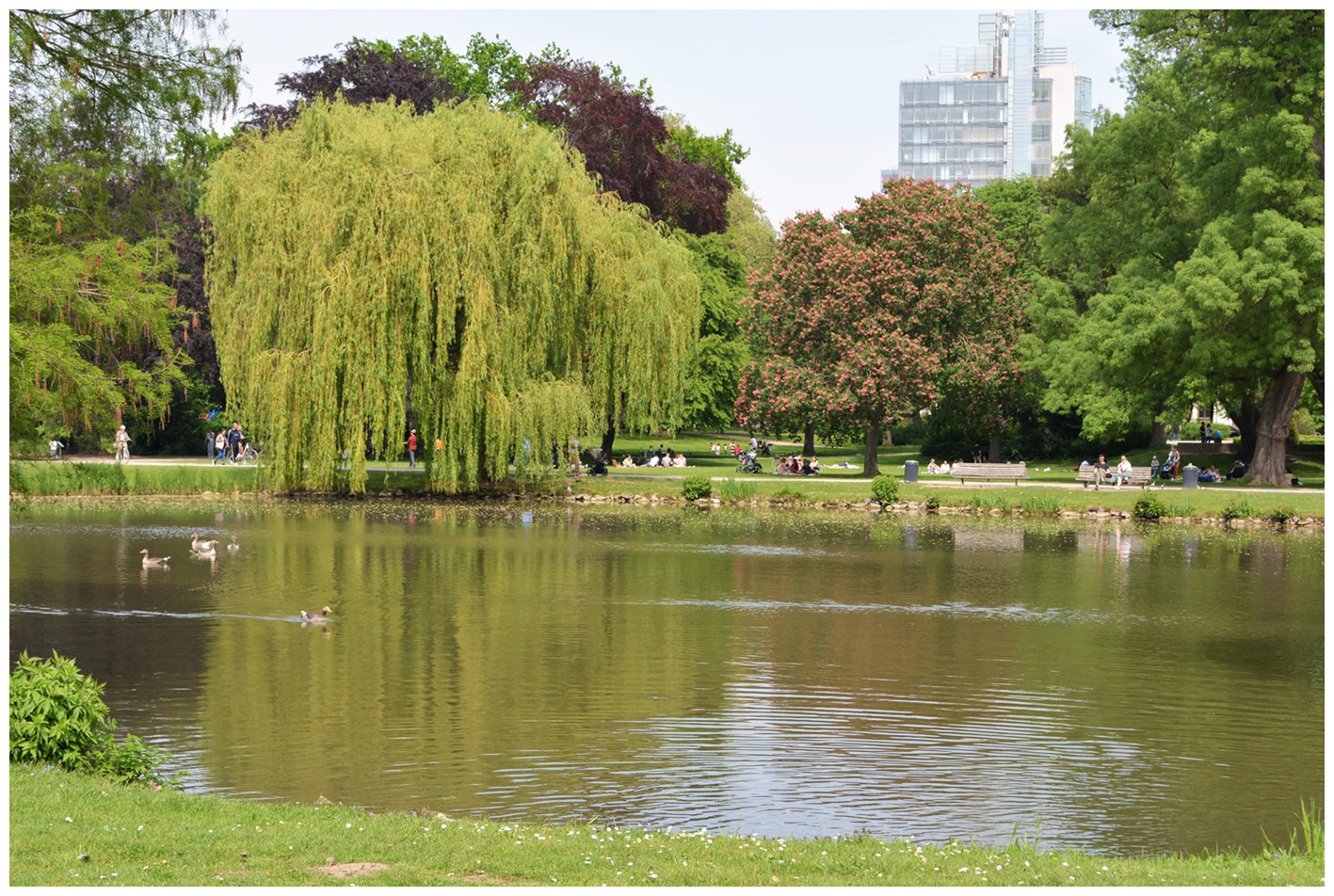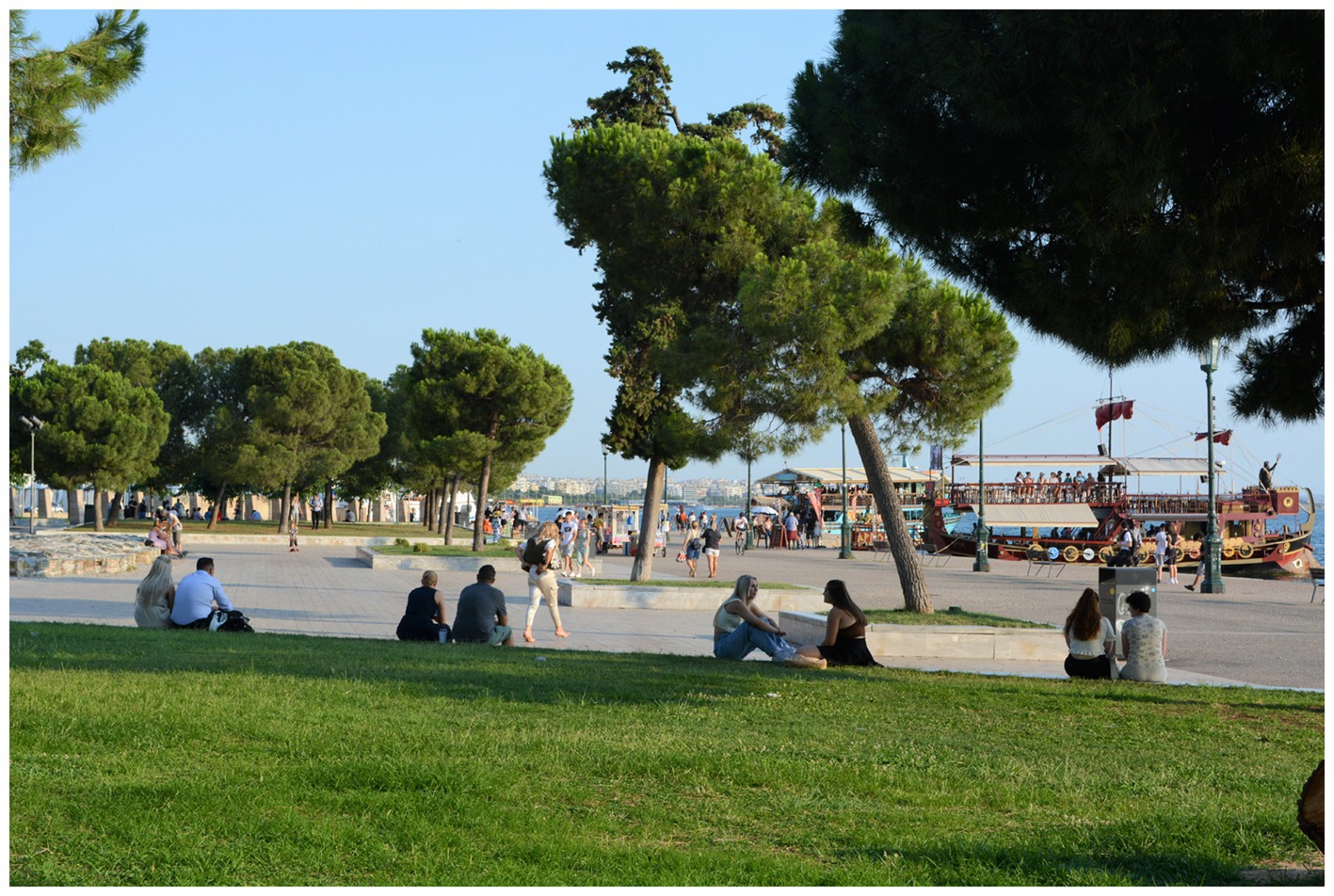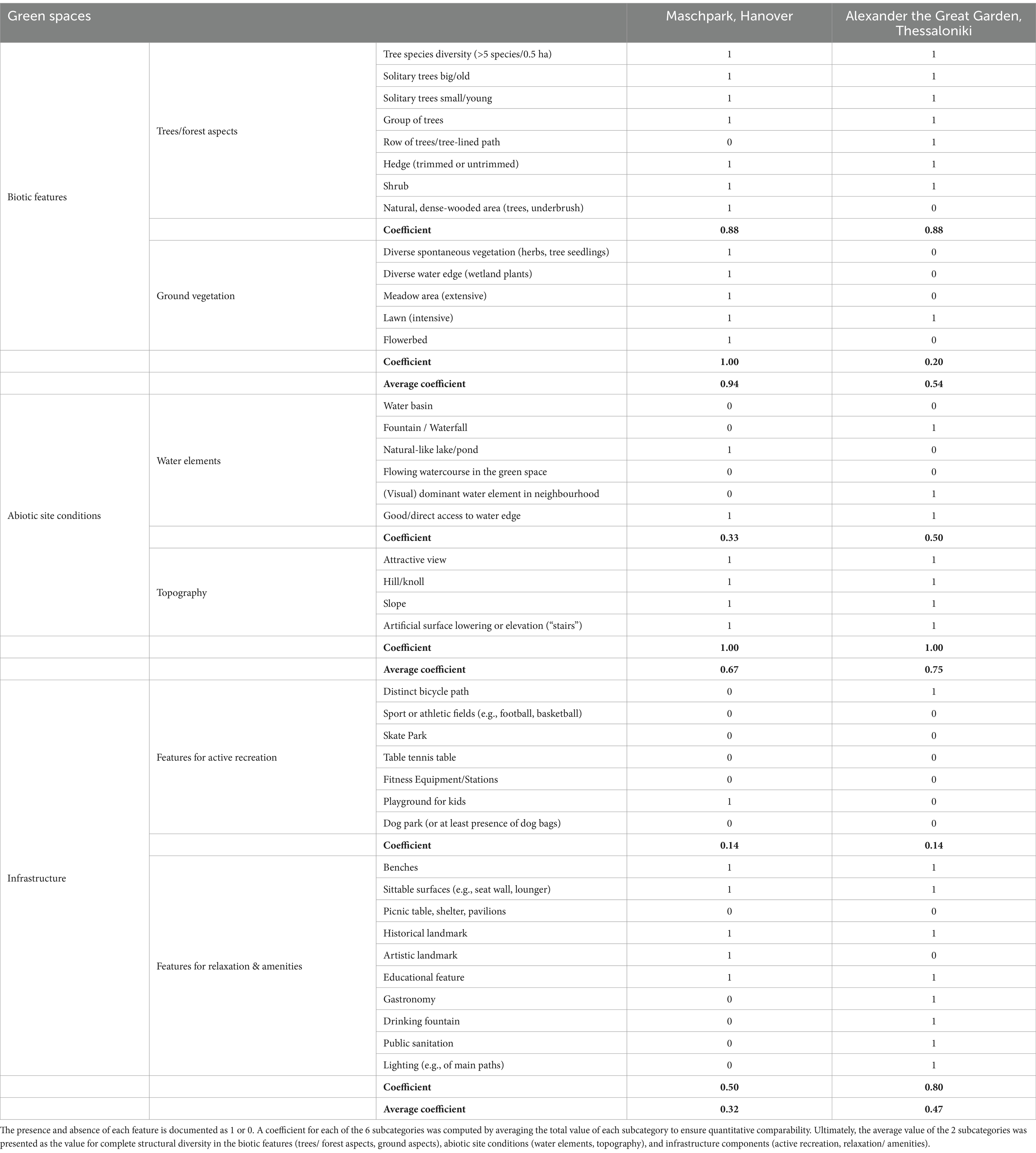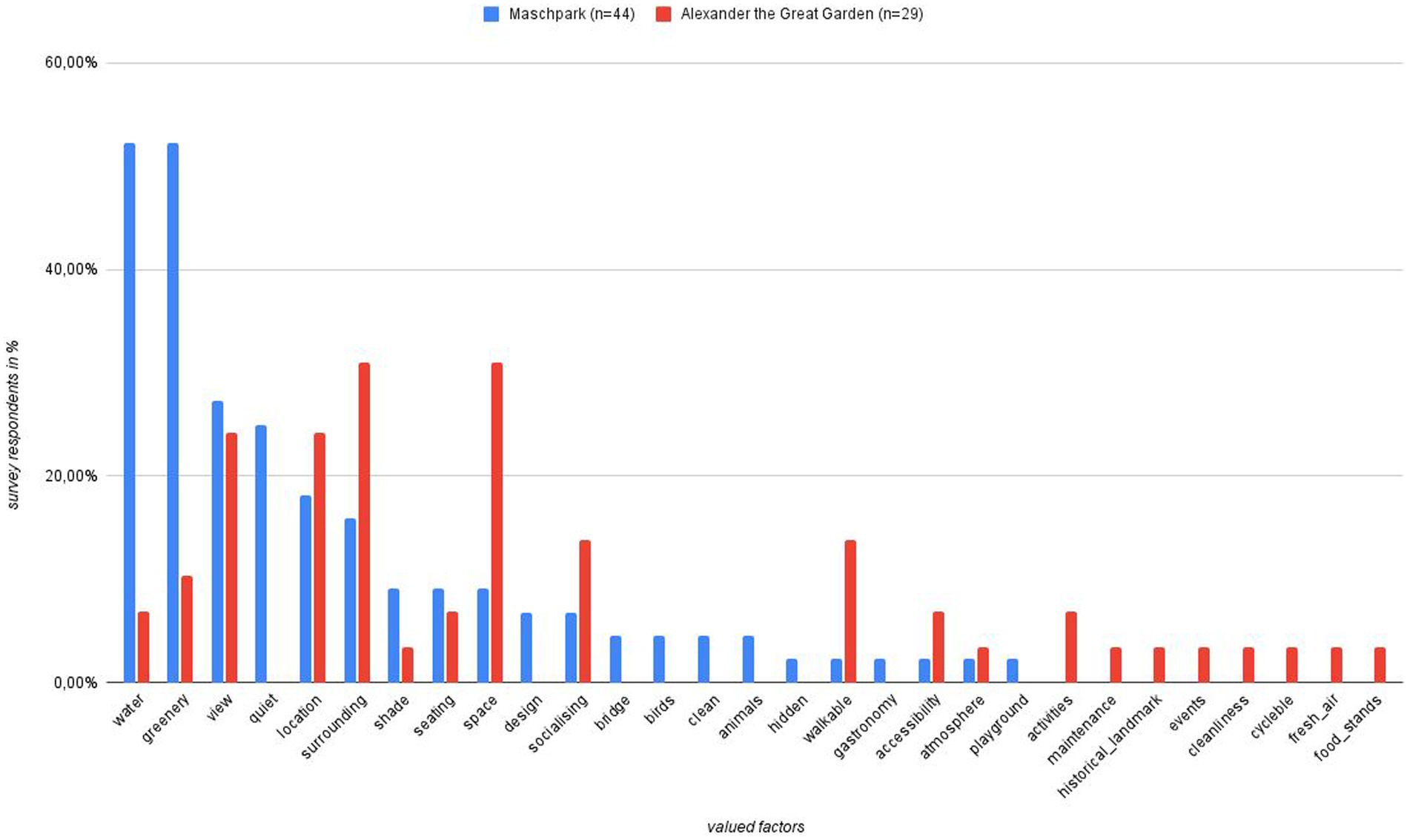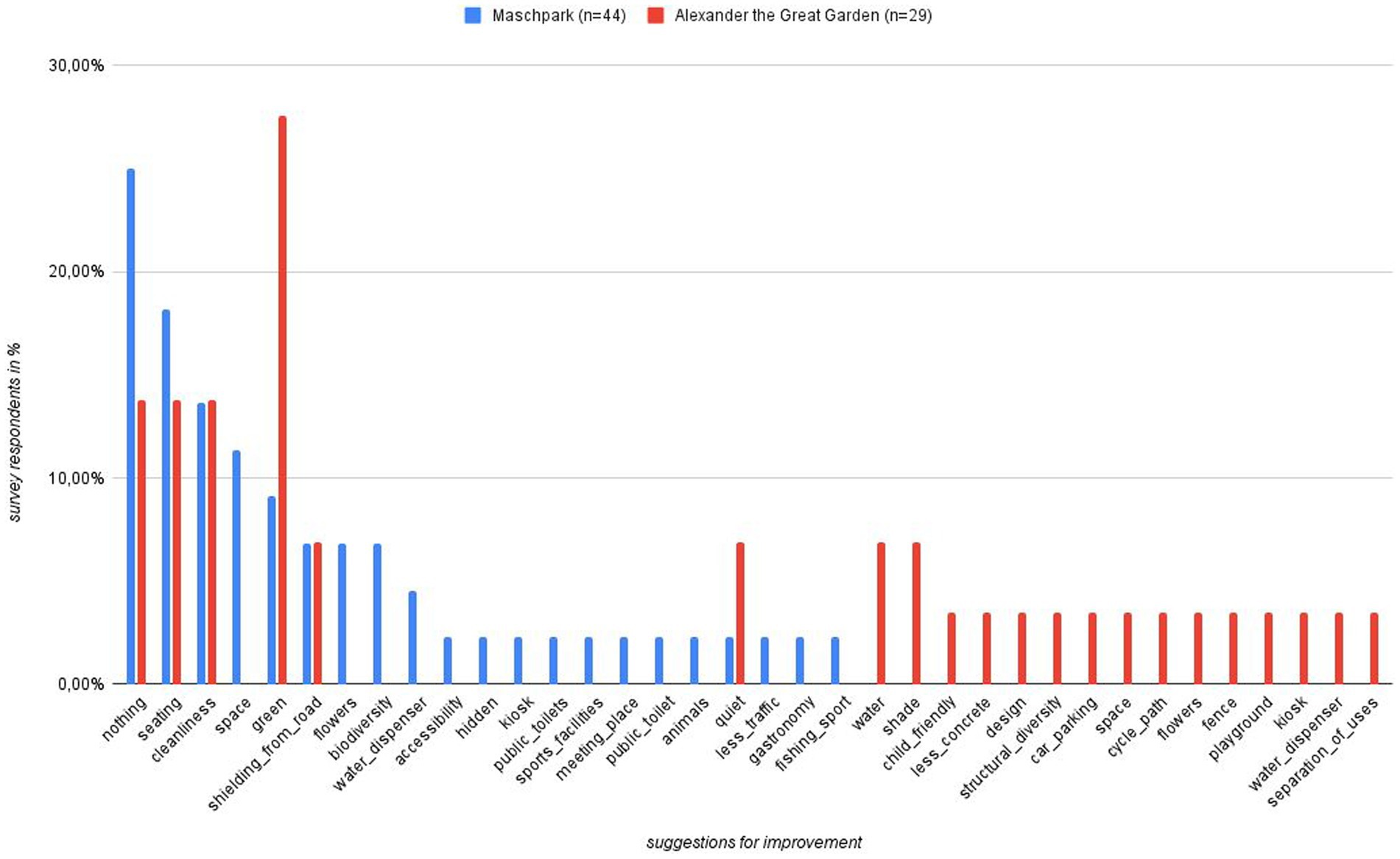- 1Institute of Environmental Planning, Leibniz University Hannover, Hanover, Germany
- 2School of Spatial Planning and Development, Aristotle University of Thessaloniki, Thessaloniki, Greece
- 3Department of Landscape Planning and Nature Conservation, Competence Centre Cultural Landscape (CULT), Hochschule Geisenheim University, Geisenheim, Germany
Studies on Urban Green Spaces (UGSs) often focus on quantity and/or proximity but lack qualitative assessment, which is particularly important in the case of cross-regional comparisons. This paper comparatively examines the quality of UGSs in Hanover (Germany) and in Thessaloniki (Greece) considering their contrasting characteristics, layouts, climate, and culture. Using a combination of tools including multi-dimensional mapping, direct observation, and user survey, 20 inner-city green spaces in Hanover and Thessaloniki were assessed and analysed in a previous study. Based on these results, this paper focuses on the two most popular UGSs from each city: Maschpark and Alexander the Great Garden, respectively. Distinct differences exist in terms of their structural diversity, with Maschpark prioritising biotic factors, while in Alexander the Great Garden infrastructure and abiotic factors are prevalent. In both UGSs a high number and a wide range of recreational activities were observed. Survey showed that presence of greenery and biotic elements primarily influence users’ satisfaction in Maschpark, while in Alexander the Great Garden, cultural significance and location on the waterfront contribute to its popularity. This study highlights the value of cross-regional comparison of UGSs to better understand which design factors contribute to their quality and enhance user satisfaction. Despite the differences of the urban landscape between Greek and German cities, notably in terms of green area per capita, results revealed that people’s use of UGSs have more in common than stereotypically implied and that users’ needs are to a great extent cross-cultural.
Introduction
Urban Green Spaces (UGSs), a staple in urban planning, offer a multitude of benefits to the environment, the economy, and to social wellbeing (cf. Karagianni, 2023; LHH (Landeshauptstadt Hannover), 2020; Voigt et al., 2014). Economically, they contribute to the appeal and image of urban areas, fuelling tourism and sustainable food and wood production, whilst appreciating the value of surrounding real estate (LHH (Landeshauptstadt Hannover), 2020). Ecologically, UGSs foster biodiversity and conserve nature, providing homes for wildlife, and regulate climate, air quality, water balance, and soil conservation (ibid). These functions are crucial in managing rainwater and floods thus amplifying urban resilience (cf. Karagianni, 2023; Coutts and Hahn, 2015). Socially, they enhance health and wellbeing and support recreational and social activities, encouraging human interaction and physical activity (LHH (Landeshauptstadt Hannover), 2020; Ward Thompson, 2011). Their cultural and aesthetic contributions (Wang et al., 2019), include hosting events and preserving historical landmarks, further enriching the societal fabric (Ward Thompson, 2002). Research shows a correlation between frequent green space visits and improved mental and physical health (cf. Romagosa, 2018; Houlden et al., 2019; Liu et al., 2019; Martin et al., 2020). On the contrary, lack of exposure to nature heightens the risk of depression and diminishes the quality of life (Whyte, 1980; Xie et al., 2019).
Recreational opportunities provided by UGSs, including presence of sports facilities, playgrounds, and natural elements, not only meet recreational needs but also contribute to overall happiness and quality of life for individuals and society (Gulam, 2016; Clark and Stankey, 1979). The term “recreational opportunities” encompasses a range of activities, amenities, and features within a specific environment, each tailored to individual preferences (Clark and Stankey, 1979). Ultimately, a diversity of high-quality recreational opportunities, both within individual UGS and across larger urban conglomerates, are essential in meeting the varied needs and preferences of the populace (ibid).
Pioneer public life researchers including Jane Jacobs, Marcus and Francis, Jan Gehl and William Whyte have all utilised various research methodologies to study user preferences on UGSs and proposed individual ideas on how to cater users´ needs through physical designs of UGSs. Jacobs (1993) offered a quintessential critique of modernist urban planning and emphasised the importance of understanding how people use urban spaces. She advocated for observing the social and functional aspects of city life to design spaces that cater to community needs, including the use of parks and green areas. Marcus and Francis (1998), focused on user-centred design approaches, Gehl (1987) emphasised using observational studies to understand public space usage patterns whereas Whyte (1980) pioneered the use of time-lapse filming and other on-site observation techniques to analyse human behaviour in public space. Through different methodologies, they all emphasised the importance of physical design of outdoor urban spaces in catering for users’ needs, especially in terms of recreation and social encounters.
This paper is a comparative study using results from a previously conducted public life study on designs and qualities of UGSs in Thessaloniki (Greece) and Hanover (Germany).
As part of a master’s thesis, one of the authors (Ingmann, 2023) analysed inner-city 20 UGSs (10 in each city). The quality of these spaces was assessed in terms of recreational opportunity availability, user preference/demand and reported drawbacks, using and combining a range of tools including multi-dimensional mapping, user survey, and observational study. The overall ranking of the 10 UGSs in each city was based on both objective and opinion-based criteria: frequency of use, based on counting visitors through site observation, and users’ preferences and users’ satisfaction level, as reported in the survey. It was found that there is a big disparity between the best and worst performing green spaces in both cities, showing that whilst both cities are capable of developing well-suiting green spaces, not enough attention/ funding is utilised for all. On a more general level, the tools of mapping and observation showed that there is an overall objective difference in the level of quality between the two cities, with Hanover’s green spaces being better maintained and having more recreational opportunities. However, opinion-based survey assessment showed that surprisingly, user preference remains overall on a similar level for both cities, with Thessaloniki boasting a slightly better reputation in certain cases.
Based on these previous results, the scope of this paper is to provide insight on the relationship of the physical characteristics of UGSs and the recreational activities that are taking place in them, as well as with people’s satisfaction level from them. The paper focuses on the two highest scored UGSs among the 20 that were assessed, one from each city. The aim is to compare the findings in these two cases to understand which aspects of physical design attract users, what factors influence user satisfaction levels and what kind of improvements could be suggested.
Hanover and Thessaloniki: setting the framework for a comparison of UGSs
Comparing UGSs in cities belonging to different geographical regions, such as Thessaloniki and Hanover, requires an understanding of the differences between the two cities in terms of urban, economic, and cultural histories as well as their urban morphologies, geographic significances (United Nations Statistics Division, 2024), and climatic zones (PVSITES, 2016). The diagram in Figure 1 shows the general context of comparisons between the two cities.
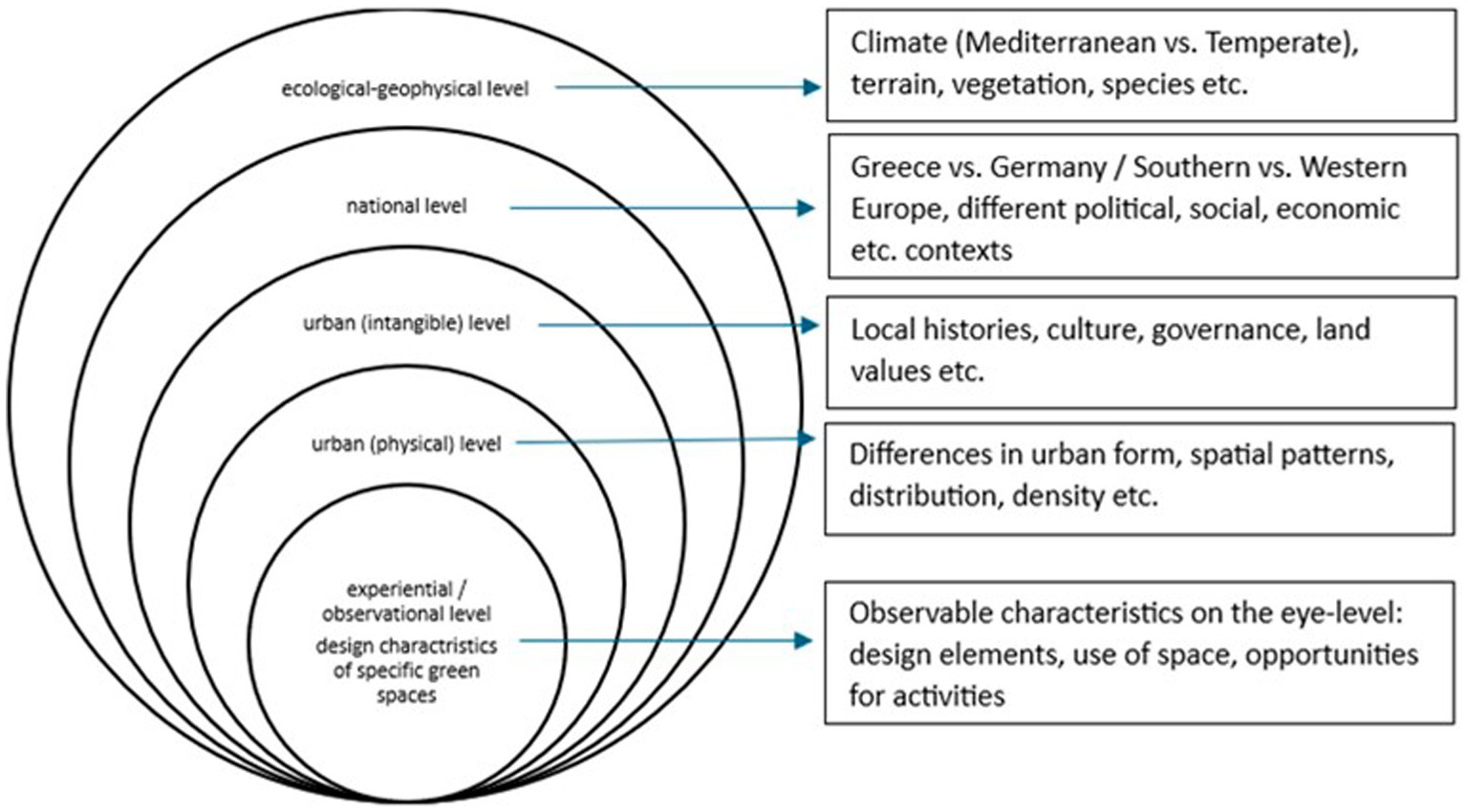
Figure 1. The concentric scales of differences between the two good practice examples of UGSs of Thessaloniki and Hanover. Source: Authors.
Comparative studies on UGSs
Starting from the macro scale, comprehensive comparative studies on UGSs between cities and across geographical regions usually combine demographic data with open geodata (Kabisch et al., 2016), using quantitative methodologies, such as landscape metrics and statistical analysis (Badiu et al., 2016). An indicator of greenness of an urban centre is the percentage of green spaces to the total urban area (Schumacher, 2023) or the percentage of urban tree cover to the total area (European Environmental Agency, 2021). Another methodological tool to compare UGSs of various urban centres is the satellite-based normalised difference vegetation index (NDVI), weighted against population, with higher values indicating higher greenness levels (Romanello et al., 2021). In the European context, Greek cities consistently score significantly below average, and lower than German cities in all metrics. For example, among European capitals, total green infrastructure areas amount to 17% in Athens as opposed to 52% in Berlin, while the average for the 38 members of the European Environmental Agency is 42% (European Environment Agency, 2022). The median urban tree cover in Greek cities is 14.95% while in German cities it is 32.75% (European Environment Agency, 2022).
A commonly used indicator for comparing availability of UGSs across geographic regions is the amount of UGSs per capita. As a metric for health benefits, the World Health Organisation proposes a minimum threshold value of 9 m2 of UGS per capita (Russo and Cirella, 2018). However, this indicator is quite generic and fails to account the characteristics of cities, the socio-economical and landscape traits or the structure of UGSs (Badiu et al., 2016). For example, the main characteristic of Greek cities is their compact form and high population densities—it is quite expected, therefore, to show very low per capita green space allocation (Fuller and Gaston, 2009). A better indicator of access availability to green spaces is the percentage of population living within a 300 m or a 500 m distance from a green area (Buckland and Pojani, 2023; Kabisch et al., 2016). According to the study of Kabisch et al., 2016, in which the authors examined the provision of UGSs of minimum 2 ha in 299 urban areas across Europe with more than 100.000 inhabitants in Western countries such as Austria and northwestern Germany, more than two thirds of the population were found to have access to greenspaces within a 500 m distance, while in Southern Europe and mainly in Greece, the value drops to below 40%. The authors proposed various explanations for the low greenness levels of cities along the Mediterranean coastline, on the basis of ecology. These include the high degree of impervious cover and rock surface, the large-scale deforestation of the sensitive Mediterranean sclerophyll forests leading to the emergence of today’s Macchie vegetation (Grove and Rackham, 2003), and the cost of the upkeep of green spaces under Mediterranean climate (Pincetl et al., 2013).
In parallel to studies based on geodata, a growing body of literature adopts a multivariate analysis of UGSs (Grafius et al., 2018). The integration of urban morphology in studying UGS provision for intra-city comparisons of UGSs and their disparities shows that the spatial patterns of UGSs have an impact on the ability to provide ecosystem services and, thus, human wellbeing (Pezzagno et al., 2021). Such an integrated analysis could help avoid oversimplification when interpreting UGS-related disparities and their potentially biassed quantification (Łaszkiewicz et al., 2022). A more site-specific approach would entail looking into the complex social, economic, and cultural system of how green spaces in each city were produced and historically maintained, especially given the fact that the green spaces under study are located in the inner city which are also the historic centres of the respective cities. How green space is organised is interrelated to how the entire urban space is produced, therefore green spaces are linked to cultural meanings around nature, dominant landscape ideologies, and the economic realm via the structuring of land values (Loughran, 2020), as well as power relations, political governance. Issues of planning regulations should also be considered. For example, while in Germany the provision of green space is mandatory, Greece has no such mandatory regulations (Kabisch et al., 2016). All these parameters would need to be considered in any attempt to explain disparities in UGS provision between the two cities.
Hanover: geographical and historical traits and its green spaces
Hanover, located in Northern Germany, serves as the capital and largest city of the state of Lower Saxony. Its strategic position in the heart of Germany makes it a significant transportation hub and an important economic centre. The central location provides easy access to other major cities in Germany and Europe, contributing to its urban atmosphere. In 2023 (30.06.2023), 546,500 people lived in the city.
The city’s history dates back to the 12th century, and its star-shaped city layout emerged after a devastating fire in 1189. The city centre was heavily bombed during World War II, leading to its complete destruction. The reconstruction efforts, led by city architect Rudolf Hillebrecht, focused on accommodating Hanover’s role as a major transportation intersection. Hillebrecht proposed a plan that transformed the city’s layout drastically, with a city-ring acting as a wide traffic lane enclosing the expanded city centre (Zalewski and Seidel, 2006). Today, the city-ring acts as a barrier between the inner and outer areas of the city centre, with public functions dominating the inner-cityscape.
In recent times, the city has been striving to reinvent itself, considering changes to the infrastructure and reducing car dependency. However, concrete plans for the future of the major infrastructure, such as potential closures or repurposing of sections of the city-ring, are still under discussion. A new traffic concept was recently released aiming for a car-free city centre, with implementation by 2030 (NDR, 2023). Currently with a mayor of the Green Party, the city embraces a sustainable approach to urban planning, gaining momentum, reflecting a growing awareness of the need for sustainable urban development (Neue Presse, 2021a,b).
Hanover boasts a rich history of public green spaces, with parks playing a vital role in the city for over 350 years (LHH (Landeshauptstadt Hannover), 2020). The city has a high proportion of green spaces per inhabitant and values its green and open spaces. A representative survey conducted in 2015 found that the overall satisfaction of residents with their green and open spaces was quite high, with 83% of respondents reporting high satisfaction (LHH (Landeshauptstadt Hannover), 2015).
In total Hanover has to offer 9,380 ha of green spaces including parks, play areas, allotments, cemeteries, forests, moors, agricultural land, water areas and sports areas, which equals 45.9% of Hanover’s land cover resulting in 172.6 m2 per inhabitant. Green spaces make up 7.9% (1,620 ha) of Hanover’s publicly and restrictedly accessible green spaces, providing residents with 529.8 m2 of green spaces per inhabitant (LHH (Landeshauptstadt Hannover), 2020).
Thessaloniki: geographical and historical traits and its green spaces
Thessaloniki is a city-port of the Eastern Mediterranean, located on the Thermaic Gulf of the Aegean Sea in northern Greece. Being the capital of the region of Central Macedonia, Thessaloniki plays a vital role as a cultural, economic, and educational hub. With a population of 802,392 inhabitants in 2021 (Hellenic Statistical Authority, 2023), Thessaloniki Urban Complex is the second most-populated urban centre in Greece. It consists of seven municipalities, of which the largest is the Municipality of Thessaloniki, with a population of 319,045 in 2021.
Strategically situated along the ancient Via Egnatia and on the crossroads of the Aegean Sea and the Balkans (Katsavounidou, 2000), Thessaloniki has been inhabited for more than 2,300 years ever since its foundation in 315 BC. After the Hellenistic, Roman, Byzantine, and Ottoman eras, it became part of Greece in 1912. The city had a particularly cosmopolitan identity during the Ottoman period, with different ethnic and religious communities including Spanish Jews, Turkish, Greek, and Franks, living in separate quarters. From the mid-nineteenth century onwards, the city underwent gradual modernization and expansion, with the demolition of sea walls, the construction of a modern quay, the establishment of rail links, and the development of a central business sector (Rotzinger et al., 2021). During World War I, in 1917, the city suffered a devastating fire, destroying the historic centre. After the fire, the city centre was rebuilt with a new European-style urban plan under the direction of French architect Ernest Hébrard.
In the postwar decades, Thessaloniki’s urban landscape became dominated by dense apartment blocks and canyon-like streets, with occasional gaps displaying historical sites. This urban morphology contributes to the urban heat island (UHI) effect, resulting in the city centre found to exhibit the highest discomfort index (Giannaros and Melas, 2012). The lack of green spaces significantly contributes to the phenomenon since the city has one of the lowest ratios of green space per resident in Europe, with only 2.6 m2 per inhabitant (Latinopoulos et al., 2016). This lack of green space, compared to the European average of 8–10 m2 is further compounded by high residential densities (COT (City of Thessaloniki), 2017).
In the past years, as the effects of climate change become more and more evident, Thessaloniki has been experiencing frequent extreme weather events, such as rainstorm floods (Liapis, 2023) and heatwaves (Archontidou, 2024), which are predicted to worsen in the near future (Kartalis et al., 2022). Air pollution is also alarmingly high, especially in regard to particulate molecules, due to traffic congestion and industrial pollution, which constitutes a constant health hazard (Lykesas, 2017).
The two green spaces used as case studies
A previous study (Ingmann, 2023) analysed and compared 20 UGSs located in the centre of Hanover and Thessaloniki (10 in each city). To identify the existing inner-city UGSs, a central point was first defined in both cities. In Hanover, the main entrance to the central railway station on Ernst August Platz was chosen as the central point (Figure 2). In Thessaloniki, the main railway station is located outside the city centre. Therefore, the intersection between the pedestrian street Odos Aristotelous with the main axis Egnatia Odos was selected as the central point (Figure 3). These central points represent strategic central locations within the cities, allowing for the analysis of all publicly accessible green spaces within a radius of 1.5 km. The green spaces located within this radius were chosen (Figures 2, 3). Two additional criteria were defined to ensure comparability between the green spaces and compatibility of the green spaces with the aims of the study: the size criterion of 1–10 ha and the condition of public accessibility. The radius from the central point and size criteria were utilised to assess a manageable number and size of green spaces to ensure the focus on the city centre. This previous study identified the most popular UGS from each respective city: Maschpark in Havover and Alexander the Great Garden in Thessaloniki. The ranking of the 10 UGSs in each city was based on three criteria: users’ preferences (replies to the question “Which green space is your favourite”), users’ satisfaction level (replies to the question “How would you rate the UGS” using a Likert scale from 1 to 5), and frequency of use, based on counting visitors through site observation. These two UGSs (Maschpark and Alexander the Great Garden) are hereby used as the basis for further comparative studies. Choosing the ‘best’ space in each city provides the opportunity for a nuanced comparison; if, for example, the lowest rated UGSs were chosen instead, the findings related to diversity and observed activities would be too poor, as those ‘bad cases’ are characterised by both very low-quality physical design and low numbers of visitors. Case selection criteria are summarised in Table 1.

Figure 2. Map of Hanover, showing locations of 10 inner-city UGSs, including Maschpark. The outer concentric circle has a radius of 1.5 km from the central point. Source: Authors; background by Snazzymaps (n.d.).
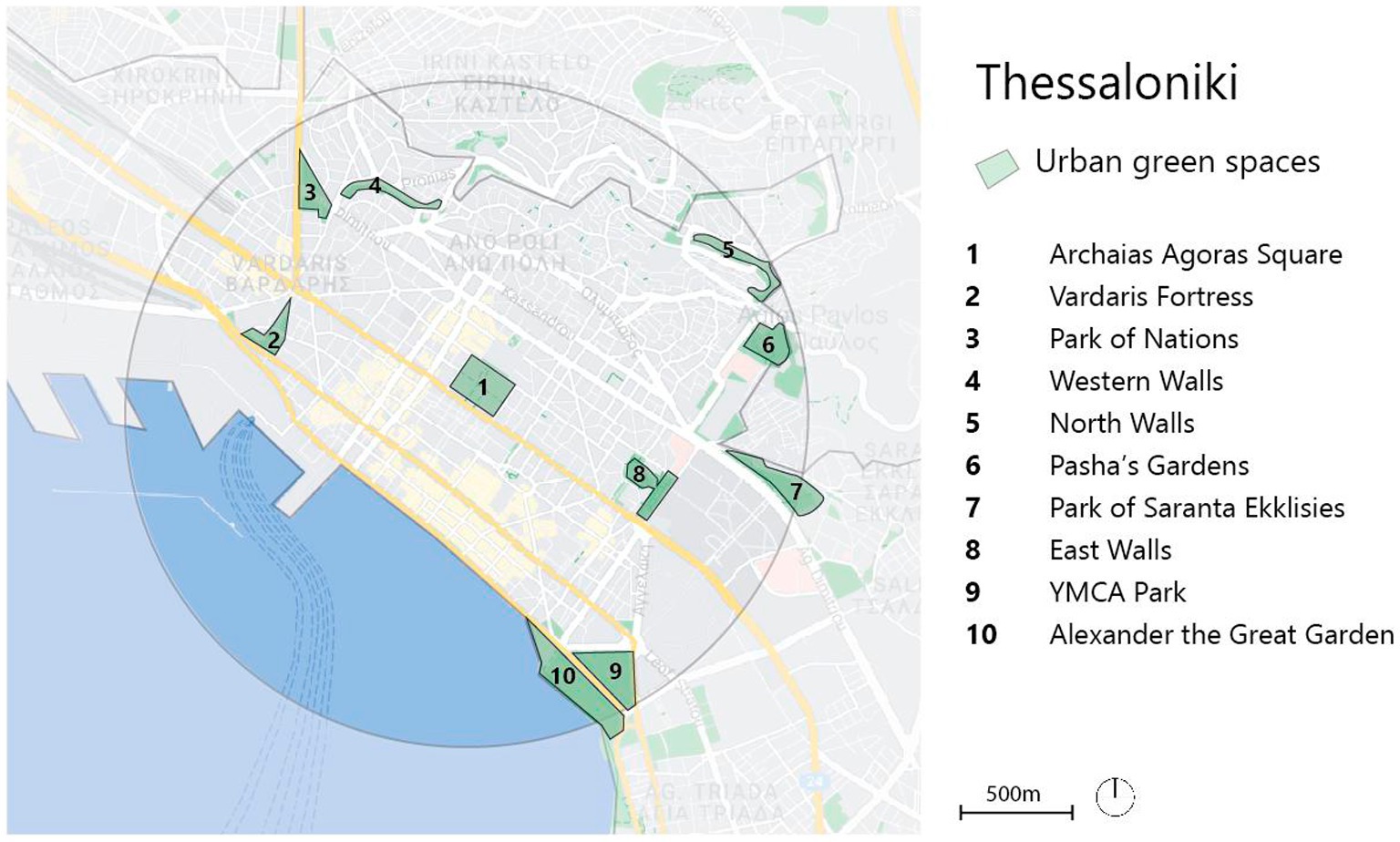
Figure 3. Map of Thessaloniki, showing locations of 10 inner-city UGSs, including Alexander the Great Garden. The outer concentric circle has a radius of 1.5 km from the central point. Source: Authors; background by Snazzymaps (n.d.).
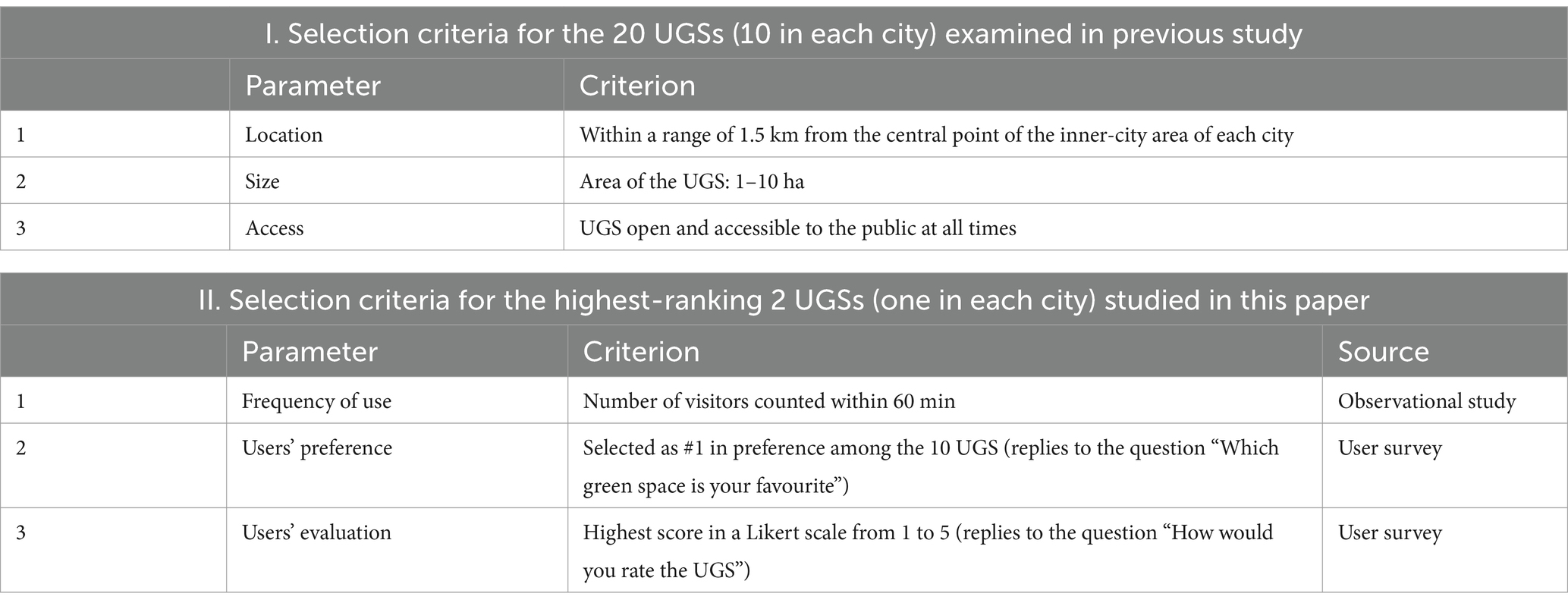
Table 1. Summary of selection criteria for the 20 inner-city UGSs and the two UGSs which are the case studies of the paper.
In Hanover, the chosen UGS is Maschpark, a park at the core centre of the city, next to the Town Hall (see Figures 2, 4). located 1.1 km south of the main station, it can easily be reached with public transport. Planned by the garden director Julius Trip in 1900, it was the first park for Hanover’s citizens (LHH (Landeshauptstadt Hannover), 2020). Today, Maschpark covers an area of 10 ha, a large part of which is covered by water. The six-lane city-ring borders the UGS. In addition, the town hall with its Trammplatz is located here in the north, as well as a museum and government buildings. The Town Hall has a restaurant facing the Maschpark. To the west, another UGS (Leine Grünzug) borders behind the road. At the southern tip of the park, the Maschsee lake adjoins behind a row of trees. To the east is a hotel and two museums.
In Thessaloniki, the UGS in focus is Alexander the Great Garden, a centrally located park next to the city’s major landmark, the White Tower, (see Figures 3, 5). The UGS covers an area of 5.72 ha which is mostly paved and grassy. The UGS forms part of the linear green space that creates a promenade along the waterfront. Its present design dates from 2009, after architects Nikiforidis and Cuomo redesigned the entire New Waterfront of Thessaloniki (Nikiforidis and Cuomo, 2009). Apart from the White Tower, the State Theatre with its café are also located nearby. The UGS is easily accessible by bus. Towards northwest, on the city-facing side of the UGS, there are sidewalk restaurants with small-scale green structures in front of them. To the southwest. The UGS borders on the Mediterranean, with views of Mount Olympus visible on the opposite shore.
Aim and research questions of the comparative study
Using diverse methods, including mapping, on-site observation and user surveys, the study aimed to answer the following research questions:
• At city level (Hanover and Thessaloniki):
• What are the reasons people visit an UGS?
• Which specific features attract people to UGSs?
• In the two specific UGSs (Maschpark and Alexander the Great Garden):
• Which of the two UGSs offers the highest structural diversity for recreational activities?
• Which of the two UGSs is more densely used?
• What are the activities observed in the two UGSs?
• Which factors influence user preferences in the two UGSs?
• What are users’ preferences and satisfaction levels of the two UGSs?
• Which factors need to be improved within the UGSs?
Materials and methods
A diverse range of methods were used to analyse and assess the quality of the UGS including mapping of multi-dimensional structural diversity, physical observation, and web-based user surveys. The mapping of the multi-dimensional structural diversity for recreation was carried out according to the template of the assessment tool form proposed by Voigt et al. (2014). Unlike other mapping tools such as POST (Public Open Space Tool), EARPS (Environmental Assessment of Public Recreation Spaces) or BRAT-DO (Bedimo-Rung Assessment) which focus only on physical activity facilities or biodiversity, Voigt et al. (2014) utilises a tri-categorical approach with each consisting of two subcategories. The three major categories include biotic features, with the subcategories of “trees/forest aspects” and “ground vegetation”; abiotic site conditions with the subcategories of “water elements” and “topography”; and infrastructure, with the subcategories of “active recreation” and “relaxation/amenities.” This tool was adapted to conditions in Thessaloniki and Hanover (Ingmann, 2023). The mapping took place in Hanover between May and June of 2023 and in Thessaloniki in June and July of 2023 to avoid the thunderstorm season.
For the observation, literature from different observational studies and the book “How to Study Public Life” by Gehl and Svarre (2013) were consulted. By dividing activities and people into subcategories, specific and useful knowledge about the complex interaction of life and form in public space can be obtained. The observation used counting, a walking diary method, photos, and soundscape analysis. In order to compare results between the two cities, the studies were conducted for 60 min on days with good weather for staying outdoors. Good weather was defined as sunshine with not more than 20% cloud coverage on the sky, little wind and no prospects of rain or storm. Saturday and Sunday were selected as the specific study times because it was expected to be the busiest times in the green spaces. For Hanover a time frame between 2 pm and 7 pm was chosen, as it usually is the busiest time of the green spaces. In Thessaloniki the timeframe was later due to the hot weather, the green spaces got most busy from 6:30 pm till 9 pm. Depending on visibility of the green space, the observations were conducted either by standing at different spots of the green space overlooking the whole area or slowly walking through the study areas and stopping at areas of actions to record all observed activities. Counting included how many people were moving through the green space (pedestrian flow) and how many were engaged in stationary activities. This differentiation is important, as it provides insight into how much time people spend in a green space and if they come there to be in the green space or simply travelling through. Furthermore, counting included how many people were engaged in various activities in groups or by themselves, in order to gain an idea which activities are more socially engaging and if social engagement is an important component of activities in the green spaces. The question of how many people can be seen smiling within 1 h of observation can lead to a hint whether people are enjoying their time in the green space (Gehl and Svarre, 2013).
Additionally, web-based surveys using Google Forms were created to gain concrete information on people’s preferences and recreational uses for the UGSs. The survey was targeted towards local residents who are interested in using and/or improving their local UGSs. To recruit participants for the survey, a QR-code was created, and 3–5 visitors of each green space were randomly chosen during the field work and asked to participate. Additionally, posters with QR-code were hung up in the UGSs and the survey was promoted through various channels. In total, 200 responses were gathered (100 in each city). For the scope of this paper, and to analyse the data on the two most popular UGSs, the responses gathered for Maschpark (n = 41) and for Alexander the Great Garden (n = 29) were picked from the data set. The survey gave both quantitative and qualitative results. Open questions were thematically analysed to identify recurring themes or concepts such as categorising open-ended feedback about valued factors, and suggestions for improvement of specific UGS. Quantitative questions where statistically assessed.
Results
In this section, selected results from all three methodological tools used are presented for both case studies.
Reasons to visit UGSs and attractive features
Survey results show high similarities in reasons to visit UGSs for both cities (Figure 6). The top three reasons (“leisure and recreation,” “experience of nature, environment” and “communication, socialising”) for visiting green spaces were identical for both cities, in the same order, with almost identical number of votes. “Play, sport and exercise” received a similar number of votes for both cities, ranking fifth for Hanover, but fourth for Thessaloniki. “Daily routes” as a reason received more votes in Hanover, whilst “health care, neighbourhood” and “see and be seen” received slightly more votes in Thessaloniki.
Survey results on features and elements showed that biotic factors are the most important for people of Hanover, whereas there is no clear favouritism between biotic, abiotic and infrastructure in Thessaloniki. Additionally, more elements were desired by over 60% of respondents in Hanover than Thessaloniki. Interestingly, out of all elements, only 5 (“tree species diversity,” “benches,” “meadow area,” “flowing watercourse” and “attractive view”) were highly desirable in both cities at over 50%. Other elements such as “natural-like lake/pond,” “group of trees,” “solitary trees big/old,” “flowerbed,” “distinct bicycle path,” “lighting,” “public sanitation” and “seating design” were highly desired in 1 city at over 50% but still somewhat desirable in the other city as well. Lastly, the elements “fountain” and “water basin” were heavily favoured in Thessaloniki but not Hanover, whereas the vice versa is true for “hedge,” “shrub,” “solitary trees small/young.”
Structural diversity for recreational activities
Recreational opportunities offered in Alexander the Great Garden and in Maschpark were measured by the multi-dimensional structural diversity of each UGS. According to the mapping guideline (Voigt et al., 2014), the presence (1) or absence (0) of the particular features was documented, as well as relevant structural elements and the various maintenance and accessibility aspects were also accounted. A coefficient for each of the six subcategories was computed by averaging the total value of each subcategory and a final value for each dimension is calculated by averaging its two component subcategory values (see Table 2).
Overall, both UGSs score well for most subcategories, meaning they provide a wide range of recreational opportunities for the visitors, which is a possible major contributor to why both green spaces were chosen as clear favourites for their respective cities. However, detailed analysis of the subcategory scoring shows that both green spaces are severely lacking in terms of opportunities for “active recreation.” Additionally, Alexander the Great Garden also severely lacks “ground vegetation,” as in all these subcategories it scores 0.20 or lower. On the other hand, both green spaces scored exceptionally high in other parts, with both scoring above 0.8 in half of the sub-categories, which includes “Trees/Forest aspects,” “Topography” for both, “Relaxation/amenities” for Alexander the Great Garden only and “Ground vegetation” for Maschpark only. Furthermore, both scores a perfect 1.00 for “Topography” with Maschpark also scoring 1.00 for “Ground vegetation” meaning they contained all features include in the mapping tool for those subcategories.
When looking at the overall average for the three major categories, both green spaces score adequately above 0.50 for both major categories of Biotic factors and Abiotic factors, but both also score much lower for infrastructure, showing a general lack of recreational opportunities for this major category. In general, there are a lot of similarities between the two green spaces in terms of recreational opportunities, but with Maschpark prioritising Biotic factors more, whereas Alexander the Great Garden prioritising Infrastructure and Abiotic factors more.
Counting visitors and observing what they do
On-site observations provided insightful data about the use of the two UGSs. The following metrics were analysed: “total visitors,” “visitors per hectare,” “people smiling,” and those engaged in “stationary activities” (see Table 3).

Table 3. Visitors’ density, smiles and stationary activities observed, showing how the two parks compare in terms of frequency of use and observed activities, based on site observation.
Alexander the Great Garden, despite being smaller than Maschpark, attracts a significantly higher number of visitors. With 2,695 total visitors, it has a density of 471 visitors per hectare. In contrast, Maschpark, which spans 8 hectares, had 1,040 visitors, resulting in a lower density of 130 visitors per hectare. This lower density might appeal to those seeking a less crowded environment. High density in green spaces can suggest a very popular spot, possibly due to its amenities, location, or design.
The number of people smiling in each green space was quite close, with Maschpark having a slight edge at 39 people compared to 35 in Alexander the Great Garden. In relation to the total number of visitors Maschpark seems to foster a slightly happier environment, as evidenced by the higher percentage of smiling visitors. This could be due to the lower visitor density, providing a more relaxed and spacious experience. However, the numbers are both very low relative to total number of visitors and should not be used as the sole source of information to analyse satisfaction levels of the two UGSs.
Stationary activities, such as picnicking, sitting on a bench or playing football in the green space, were more common in Alexander the Great Garden, with 432 visitors engaging in such activities compared to 312 in Maschpark. This high level of engagement in stationary activities might reflect the park’s facilities or its appeal as a place to spend extended periods.
Maschpark on the other hand has a higher proportion of visitors engaging in stationary activities, with 30% of its visitors spending more time in the green space. This suggests that despite having fewer overall visitors, those who visit Maschpark are more likely to engage deeply with the environment, making use of the green space for leisure and relaxation. In contrast, Alexander the Great Garden, whilst busier, has a lower percentage (16%) of visitors participating in such activities, indicating a different usage pattern, possibly more suited to brief visits or transitory walks.
Observation also showed a large variety of activities taking place in both green spaces. Observed activities were subdivided into two major categories, pedestrian flow and stationary activities. The activities in each of these categories are then further subdivided as either passive or active, creating a total of 4 categories. The variety of activities taking place also indicates the type and level of recreational opportunities provided by the green spaces. The results of the observation show that the large majority of people are simply walking in the green spaces, but the sheer amount of foot traffic in Alexander the Great Garden is exceptionally high, with over 2,000 people observed walking through the space within an hour in compared to 622 for Maschpark, which is still a high number, especially relative to the foot traffic observed in the UGSs of the two cities. Other than walking, both green spaces had a large number of people undergoing other various active pedestrian flow activities including cycling, scootering etc. Interestingly, motorbiking within the green space is only observed in Alexander the Great Garden, making it a unique recreational opportunity. In Maschpark, few people were also observed to be walking with wheelchairs and jogging, which were not observed in Alexander the Great Garden.
In terms of passive pedestrian flow activities, many people stopped to “buy something” in Alexander the Great Garden, due to the presence of various vendors along the seafront, which is not found in Maschpark. Additionally, many people also stopped to “look at the view” in Alexander the Great Garden, an activity that was also absent in Maschpark, possibly due to lack of significant landmarks within the UGS.
In terms of passive stationary activities, numerous were exclusive to Maschpark, including “standing,” “leaning,” “picnic at the picnic table,” “barbecue on the grass,” “feeding birds,” “playing with remote controlled toys” and “guided tours.” In contrast, none were exclusive to Alexander the Great Garden.
Lastly, for passive stationary activities, both green spaces showed the biggest variety out of all four categories. However, “Playing badminton on grass” and “yoga” and “playing on the playground” were only observed in Maschpark whereas “playing around a landmark” and “skating” were only observed in Alexander the Great Garden.
User preferences, valued factors, and suggestions for improvement
According to survey respondents the most valued factors of Maschpark are its natural beauty and serene environment (see Figure 7). The picturesque pond and various water features are highly appreciated for their aesthetic appeal and calming effect. Equally with 23 mentions, “greenery” also makes a huge impact which includes the abundant plant life, including trees, shrubs, and well-maintained flowerbeds, which are shown to contribute to the park’s lush and vibrant atmosphere. The scenic vistas, particularly the views of the New Town Hall and the reflective pond, are also cherished by visitors, with the survey containing 12 mentions for the “view.” Lastly, the tranquillity and peacefulness of Maschpark also makes it a favoured spot for relaxation and escape from city noise, with “quiet” receiving 11 mentions.
Despite its central location, respondents also find the green space to be “tranquil and peaceful” which makes it a favoured spot for relaxation and escape from city noise. Furthermore, respondents also appreciate its “central location,” making it highly accessible whilst being near other attractions and landmarks. Lastly, the green space also offers ample comfort for the visitors by providing plenty of “benches” and other “seating areas” for the visitors to sit and relax, as well as “shaded areas” to protect the visitors from hot sunny days.” Moreover, the availability of benches and seating areas allows visitors to sit and enjoy the surroundings, as noted by four respondents. Other elements that received less frequent mentions in the survey include the thoughtful “design” and aesthetic value of its landscaping, the charming “bridges” within the park and the presence of birds and occasional sightings of animals. However, it is still important to note that these elements still made an impact to be mentioned by some respondents.
According to survey respondents, the most valued factors of Alexander the Great Garden are its “spaciousness” and cultural “significance” (see Figure 7). The open and expansive layout of the green space is highly valued, and so are its surroundings. The stunning views, particularly of the sea and the city, are a major attraction for visitors. The green space’s prime location also makes it easily accessible and highly appealing for the visitors.
Additionally, the green space is a popular spot for “social interactions” and gatherings for visitors. The walkability also makes it an enjoyable place for leisurely strolls. Lastly, the presence of plants and trees adds to its beauty and provides a natural retreat. Other less frequently mentioned elements include the presence of water features within the green space, the availability of seating areas and its accessibility.
Regarding user satisfaction (see Figure 8), the survey categorised responses into six levels: “Not Visited,” “Terrible,” “Bad,” “OK,” “Good,” and “Perfect.” The results are shown in Figure 9. Both Maschpark and Alexander the Great Garden received high satisfaction ratings from the majority of their visitors. However, Maschpark had a slightly higher number of “Good” ratings (43) compared to Alexander the Great Garden (34), which suggests a slight edge in visitor satisfaction. Both green spaces had an equal number of “Perfect” ratings (28), indicating that they are equally appreciated at their best. The number of visitors who had negative experiences was relatively low for both parks. These results highlight that both locations are well-regarded by the public, though there is always room for improvement based on the feedback from those who rated their experiences as “OK,” “Bad,” or “Terrible.” These three categories added together also show a higher number of negative responses for Alexander the Great Garden (32) in comparison to Maschpark (23). Respondents, who mentioned not having visited certain green spaces, could be due to personal preference or lack of awareness about those specific areas.
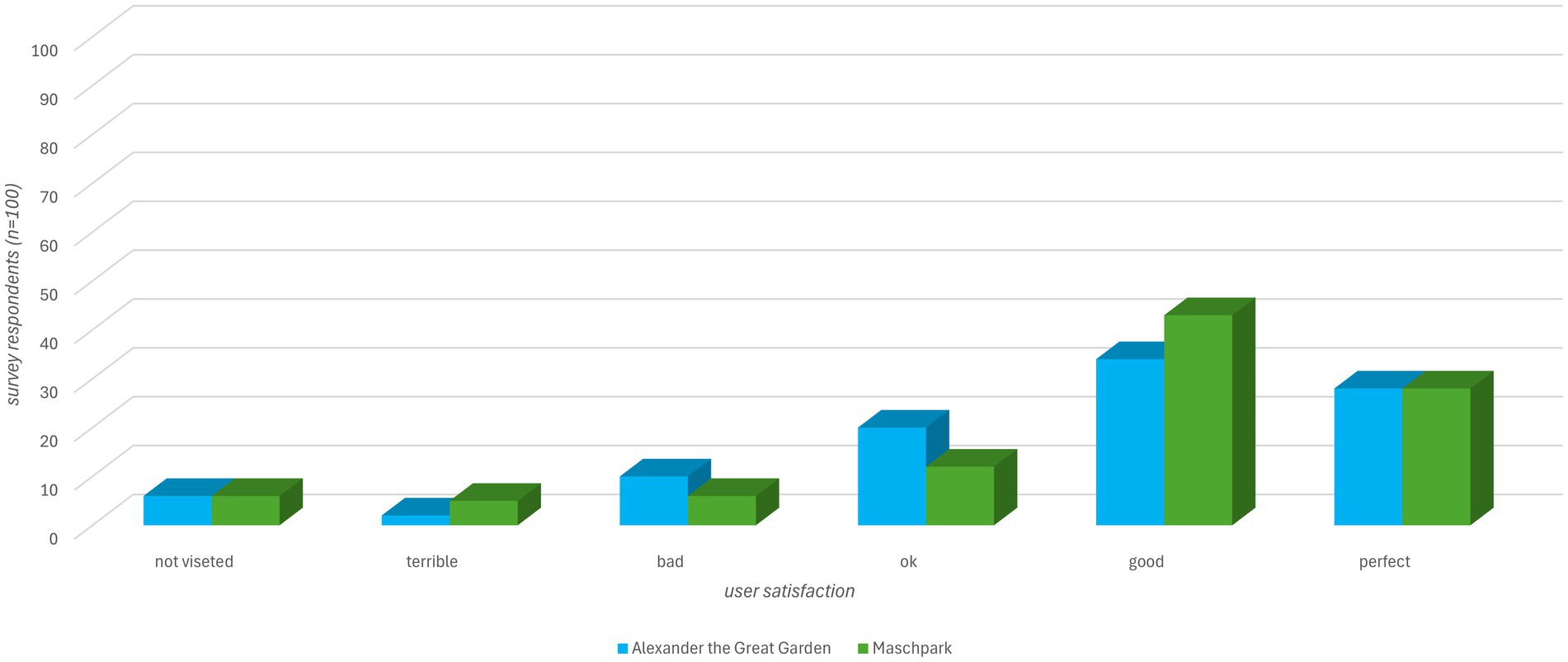
Figure 8. User ratings of Alexander the Great Garden and Maschpark (n = 100; r = 100 for each green space).
Regarding suggestions for improvement (see Figure 9), in Maschpark, a significant number of visitors feel that more seating is needed to accommodate those who wish to relax and enjoy the surroundings. Cleanliness is another key concern, with several respondents pointing out the need for more frequent maintenance to keep the green spaces pristine. The availability of open space is also seen as an area for enhancement, with some visitors suggesting that the green space could benefit from additional areas for relaxation and recreation.
Furthermore, there are calls to increase the greenery within Maschpark, with suggestions to add more vegetation and maintain existing lawns better. Noise and pollution from nearby roads are also a concern, and better shielding from traffic could improve the green space’s tranquillity. Visitors would also appreciate the addition of more flowerbeds and greater biodiversity to enrich the green space’s natural environment (Figure 10). Other suggested improvements include the installation of water dispensers, better accessibility for people with disabilities, and the addition of public amenities such as kiosks and public toilets. Some respondents also mentioned the desire for sports facilities, dedicated meeting places, and more peaceful spots shielded from traffic noise.
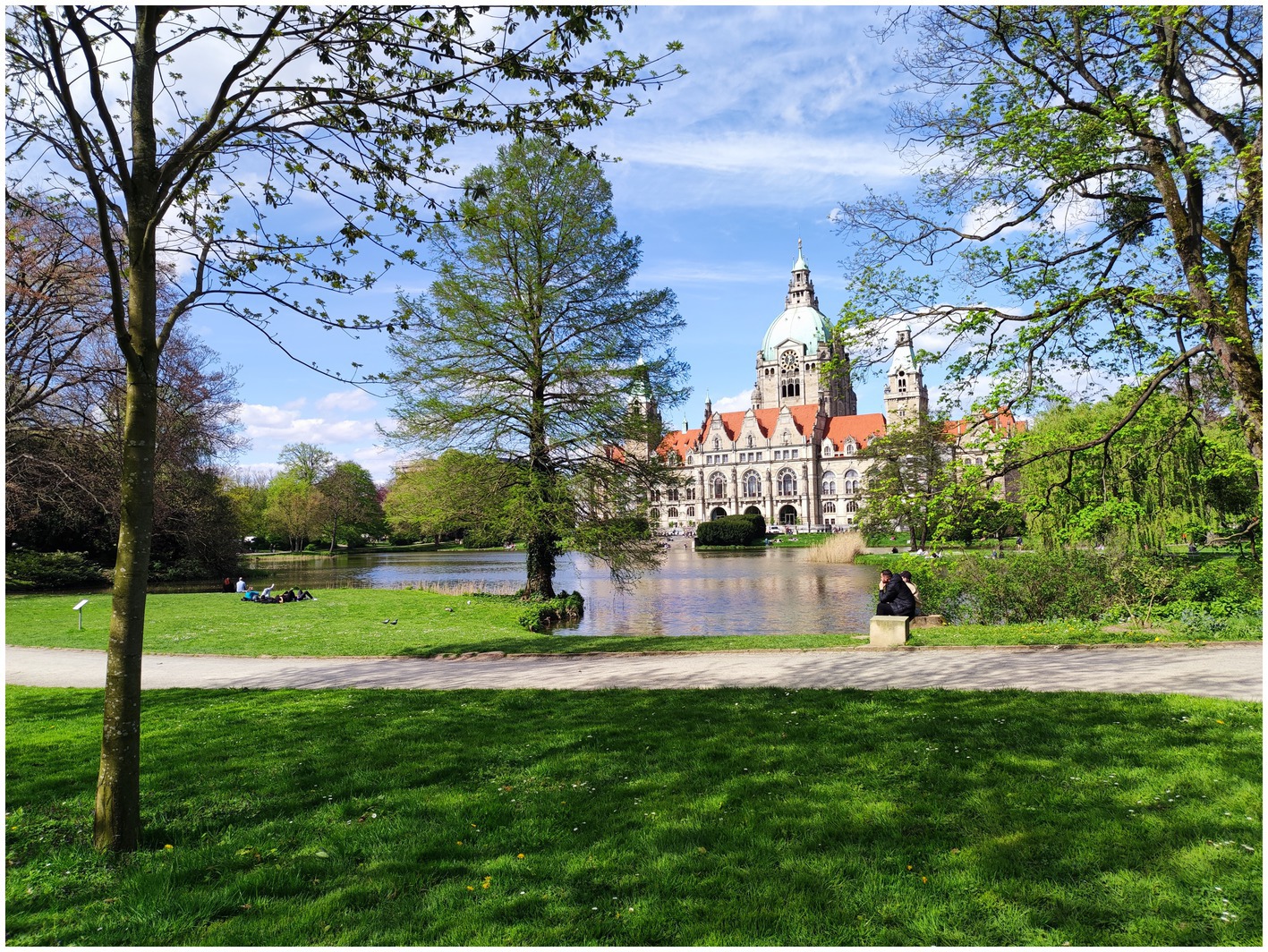
Figure 10. View of Maschpark, with existing green laws. According to visitors, the addition of more flowerbeds and greater biodiversity would enrich the green space’s natural environment. Source: Authors.
Similarly, Alexander the Great Garden has its own set of areas that require attention. The most common suggestion is to increase the greenery, adding more trees, plants, and lawns to create a more inviting and natural environment. Cleanliness is also a priority for many visitors, indicating the need for regular upkeep to maintain the garden’s appeal. Other suggestions include reducing the amount of concrete in the garden, improving its overall design, and adding more structural diversity to make the space more interesting (Figure 11).
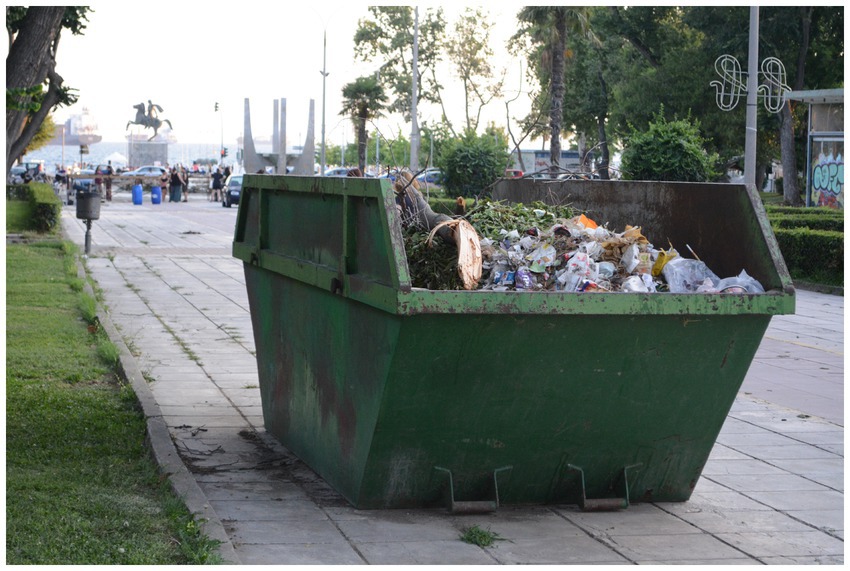
Figure 11. View of Alexander the Great Garden, showing an extensive part covered by concrete slabs, on which a rubbish tank was left. According to visitors, there is need for reducing the amount of concrete in the garden and for better upkeep and cleanliness. Source: Authors.
As with Maschpark, additional seating is a frequent request, with visitors wanting more places to rest and enjoy the garden. Shielding the garden from road noise and pollution is another important factor, as it would enhance the sense of peace and quiet within the space. Respondents also request the addition of more water features, shaded areas, and child-friendly amenities to make the green space more attractive to a broader range of visitors (see Figure 12).
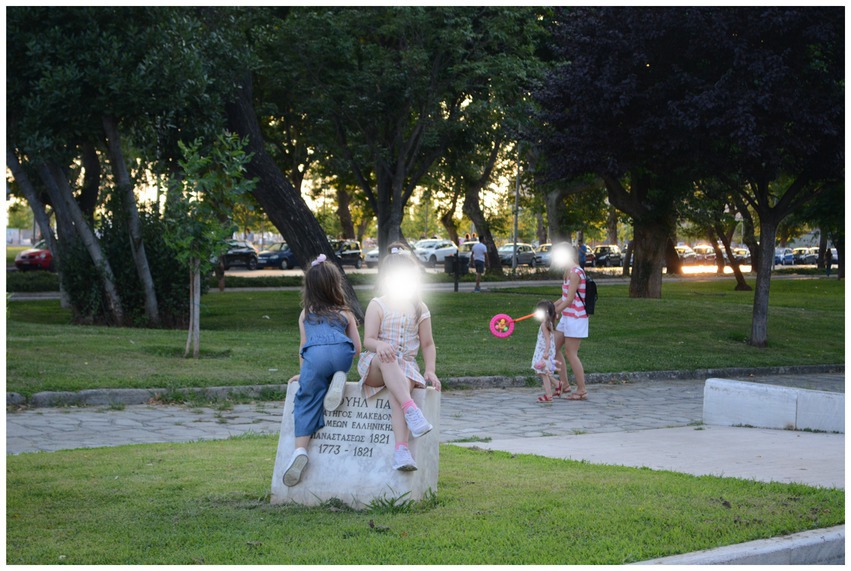
Figure 12. View of Alexander the Great Garden, showing children’s informal play. According to visitors, child-friendly equipment would make the park more attractive. Source: Authors.
Practical improvements such as better car parking, the inclusion of a cycle path, and the installation of water dispensers were also mentioned. Lastly, visitors suggested creating more distinct areas within the garden to better separate different uses and activities.
Both Maschpark and Alexander the Great Garden have much to offer, but by addressing these areas of concern, they could become even more inviting and enjoyable for all who visit. Whether it is through adding more seating, enhancing the greenery, or improving cleanliness and accessibility, these changes would significantly enhance the overall experience in these cherished green spaces.
Discussion and conclusion
The scope of this study was to examine closely the physical characteristics of the two green spaces in Hanover and in Thessaloniki, and to relate them with how people use them and the level of satisfaction about them. Both Maschpark and Alexander the Great Garden are highly valued by visitors for their unique characteristics, offering serene environments, natural beauty, and spaces for socialising and relaxation. Their central locations and well-maintained features make them cherished spots for locals and tourists alike. Despite geographical and cultural differences between the two studied areas, results show that users’ needs in UGSs coincide. They include the need for leisure and recreation, for experiencing nature and for socialising. These findings indicate that the needs and preferences for people are very similar, no matter the geographical locations or cultural backgrounds, as they all strive for enjoyable spaces with a high multifunctionality.
Statistically, Alexander the Great Garden is the more frequented green space in terms of both total visitors and visitor density per hectare. Maschpark, while less densely visited, offers a more spacious environment with a slightly higher number of people visibly enjoying their time. Alexander the Great Garden, therefore, acts as a bustling urban oasis, while Maschpark offers a more serene and engaging environment. Urban density—which is much higher in the Greek city—is a contributing factor for this difference. These insights are crucial for urban planners and green space management, as they highlight the importance of balancing visitor numbers with the quality of the green space experience.
Both green spaces serve valuable roles in providing recreational spaces for the community, each with its unique appeal. User opinions imply that improvements in vegetation, cleanliness and seating could create a more inclusive and enjoyable recreational environment for the community. Better infrastructure and amenities are crucial for providing an inviting atmosphere, as well as providing people with comfort. Additional facilities could help rid of certain inconveniences, allowing visitors to engage in recreational activities without worry for basic needs. Greenery and diversity are integral aspects of any green space. Improving them would create lush landscapes of enhanced aesthetic appeal whilst creating a more immersive natural environment with a healthier ecosystem. In terms of environment and atmosphere, reducing the negative impact of the surrounding would create a much more peaceful and tranquil environment within the green space, allowing visitors to escape the city and to truly relax in an immersive natural environment. Lastly, providing designated areas for activities like barbecuing and dog walking can help manage these activities responsibly, minimising potential conflicts and preserving the natural beauty and cleanliness of green spaces. Considering these ideas can help guide future planning and development efforts to enhance the green spaces and ensure they cater to the preferences of the community, providing a more enjoyable and fulfilling experience for visitors.
Differences at various levels and scales (historical, climatic, cultural) exist between urban spaces in the regions of Germany and Greece (see Figure 1). Urban Green Spaces have a long history in Germany; in many cities, central parks were created early on, following the English tradition. During industrialisation in the 19th century, in cities like Hanover, it became quite clear how important green spaces were for the health of the public. Greece, on the other hand, did not go under the same processes of urbanisation, which in western Europe were instigated by the Industrial Revolution. Greek cities lack such a strong tradition of UGSs. In fact, cities in Greece underwent a late process of industrialisation, only after World War II, much later than German cities. Until that time, urban districts did not face the acute problems of pollution that industrialised societies had to tackle ever since the 19th century, often through the creation of large green areas in their centres. Another crucial characteristic of Greek towns and cities is that they developed in the postwar period as very dense and compact-city environments, with scarce green spaces. Also, the fiscal structures of Germany and Greece exhibit distinct characteristics in terms of revenue allocation and administrative autonomy. In Germany, a decentralised tax system empowers local municipalities and urban centres to directly collect levies from residents and, more significantly, from enterprises within their jurisdictions. This contrasts sharply with Greece’s highly centralised fiscal framework, where the national government in Athens serves as the primary collector and distributor of tax revenues to subnational administrative units. Due to taxes better than in Greece, however financial resources and especially human resources are declining as well.
Despite the differences between Greek and German cities, results from our analysis of the UGSs in Thessaloniki and in Hanover revealed that people’s use of public spaces have more in common than stereotypically implied—thus this paper is entitled “Different, different, but same?.” Regarding how UGSs relate to human needs, wishes and perceptions, this research highlights many similarities: there is the wish and need to relax, recreate and to follow certain activities. Certain positive traits of Alexander the Great Garden appear to be missing from Maschpark, revealing that southern European cities may be less ‘green” (as quantitative studies show), but not necessarily inferior in quality of living to their northern and western counterparts. Scholars such as Jan Gehl who focused on open spaces of southern Europe to draw conclusions on how design better public spaces in Denmark (Gehl, 1987) have shown that there is a lot to “learn from each other” when it comes to public spaces in different geographical and cultural contexts, and we should approach this comparison with an open mind.
The novelty of the research approach presented in this paper lies in its combination of different methods for analysing and assessing UGSs. We analysed the quality of UGSs in terms of recreational opportunity availability, user preference/demand and drawbacks, using and combining a range of tools. This “eye-level” approach produced results that offer a different, more detail-oriented perspective in comparison to traditional analysis techniques which focus on a larger scale with more general results. For our study, the different categories of abiotic, biotic and infrastructural elements were identified and measured at the same time that the behaviours of people were observed, while additional insights were gained through the survey.
The study has specific limitations. It focuses on the two cases (the highest-ranked UGSs), thus providing more insights but does not enable generalisation for the whole city of Thessaloniki or Hanover. Due to the small number of responses (44 in Maschpark and 29 in Alexander the Great Garden), it does not comprise an advanced statistical analysis, which would render rigorous quantitative results. It might be useful to expand this research, either with a deeper focus on the two parks or by analysing and comparing the entirety of the original sample (the 20 UGSs). In the first case, a more in-depth analysis focusing on the two parks would entail a bigger number of survey responses so as to be able to perform advanced statistical analysis, as well as a more extended observational study, for longer time and at various seasons of the year. For such an extensive study, data collection would be challenging, as a team of researchers would be needed in each city. In the second case, if all of the 20 parks originally studied were analysed and compared, it would demand a different methodological approach for interpreting the results, making them more generalisable for the whole city of Thessaloniki or Hanover.
The approach implemented in this study is site-specific and requires observational study, therefore it can be replicated but entails access to resources in terms of time, people, and money. Research teams would be needed to guarantee the quality and quantity of observation. As a learning opportunity, observing behaviour is an important method to learn first-hand about similarities but also differences of people’s way of using an urban green space—a method exemplified by Gehl (1987). In general, it can be concluded that studies based on geodata and multivariate analysis of UGSs (e.g., Grafius et al., 2018) are crucial approaches and offer valuable insights. Nevertheless, trying out a combination of site-specific comparisons to get more information on what UGSs offer, what users prefer and what specific design elements make a UGS popular, are equally important for shaping better, livelier UGSs.
Recommendations for designers and planners
The results of this study, which used a multi-method approach to analyse the quality of UGSs in Thessaloniki and Hanover, show that the criteria for good quality green spaces converge in the two cities, despite their geographical, historical and cultural differences. Given the heightened importance of green spaces in cities today, as climate change advances and a good microclimate is much needed (Lenzholzer, 2015), the study is also a source of practical insights for designers and planners in order to design UGSs that will serve the citizens holistically, providing natural ecosystem services, ensuring vibrance and adding beauty to people’s everyday life in the city. When planning for new UGSs or retrofitting existing ones, green space design should cater for nature, vibrance and beauty, as shown diagrammatically in Figure 13.
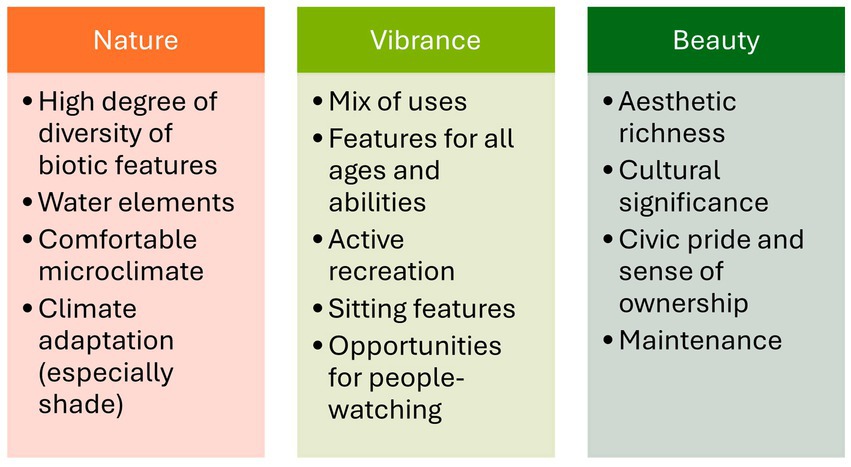
Figure 13. Key attributes for green space design UGS, summarising insights from the study. Source: Authors.
In terms of nature, design of UGSs should include a high degree of diversity, water elements, provision of comfortable microclimatic conditions and especially shade, given the rising temperatures and hot summers due to climate change. Catering for vibrance, important characteristics to include in the design are mix of uses, addressed to a wide range of ages and abilities, opportunities for active recreation, but also sitting features, providing the necessary equipment for people to stay in the place, instead of simply passing through. In terms of beauty, aesthetic qualities, especially connected with local cultural heritage, contribute to civic pride and sense of ownership of the open space, while equally important is the upkeep of the UGS, ensuring cleanliness and proper maintenance, especially regarding graffiti and other acts of vandalism and neglect.
An important takeaway of the study is that UGSs are not only green spaces, but multifunctional areas for sport, for meeting people, for kids, for new activities such as urban gardening. The development of recreational opportunities, with a variety of features, within Urban Green Spaces serves as a pivotal component of enhancing the overall quality of these public areas. Designing for a variety of recreational opportunities ensures that Urban Green Spaces can accommodate a wide range of activities and experiences. This diversity can exist within individual green spaces or across the various green spaces within a city. The total supply of biotic features, abiotic features, and man-made infrastructure should offer a rich mix of uses to attract a variety of visitors, of all ages and abilities, and provide them with comfortable, green, and inviting spaces. These qualities have to be accompanied with two fundamental features: establishing an effective maintenance scheme, involving the public in shaping and improving these spaces, and ensuring accessibility as preconditions for use.
Effective management of UGSs is essential for their continuous improvement and responsiveness to user needs. A combination of operational management and citizen participation allows for direct communication of requirements and the development of green spaces accordingly. Management should focus on maintaining cleanliness and safety, ensuring aesthetic richness, and preserving a sense of place and security. Citizen involvement, on the other hand, fosters sociability, neighbourly friendliness, and the creation of places where people feel a sense of ownership and representation. Through interactive activities within these spaces, a broader clientele can be engaged, promoting responsible behaviour among all users. By instilling a feeling of pride in these spaces, individuals are more likely to take better care of them, collaborating to provide recreational spaces that endure for the present and future generations. Accessibility is central to human-centred green spaces as it preconditions its use. The availability of green spaces in terms of size and quantity therefore must be appropriate to the demands, to prevent overcrowding. Fair distribution is vital to ensure that green spaces are conveniently located within proximity to all residents. Establishing a network of connected green spaces throughout the city enhances their accessibility further. These spaces should be easily reachable for people of all ages and abilities, designed at a human scale to enhance usability. Ensuring that spaces are easily readable, convenient, and walkable promotes freedom of movement and makes everyone feel welcome.
Data availability statement
The raw data supporting the conclusions of this article will be made available by the authors without undue reservation.
Author contributions
KI: Conceptualization, Data curation, Formal analysis, Investigation, Methodology, Software, Visualization, Writing – original draft, Writing – review & editing. GK: Conceptualization, Formal analysis, Funding acquisition, Investigation, Methodology, Supervision, Visualization, Writing – original draft, Writing – review & editing. NM: Conceptualization, Formal analysis, Investigation, Methodology, Supervision, Writing – original draft, Writing – review & editing.
Funding
The author(s) declare that financial support was received for the research and/or publication of this article. The publication of this article was supported by the Onassis Foundation Scholars’ Association.
Conflict of interest
The authors declare that the research was conducted in the absence of any commercial or financial relationships that could be construed as a potential conflict of interest.
Generative AI statement
The authors declare that no Gen AI was used in the creation of this manuscript.
Publisher’s note
All claims expressed in this article are solely those of the authors and do not necessarily represent those of their affiliated organizations, or those of the publisher, the editors and the reviewers. Any product that may be evaluated in this article, or claim that may be made by its manufacturer, is not guaranteed or endorsed by the publisher.
References
Archontidou, C. (2024). The ominous future of Thessaloniki with heatwaves [in Greek]. Parallaxi. Available at: https://parallaximag.gr/kairos/to-dysoiono-mellon-tis-thessalonikis-me-toys-kaysones (Accessed September 30, 2024).
Badiu, D. L., Iojă, C. I., Pătroescu, M., Breuste, J., Artmann, M., Niță, M. R., et al. (2016). Is urban green space per capita a valuable target to achieve cities’ sustainability goals? Romania as a case study. Ecol. Indic. 70, 53–66. doi: 10.1016/j.ecolind.2016.05.044
Buckland, M., and Pojani, D. (2023). Green space accessibility in Europe: a comparative study of five major cities. Eur. Plan. Stud. 31, 146–167. doi: 10.1080/09654313.2022.2088230
Clark, R. N., and Stankey, G. H. (1979). The recreation opportunity spectrum: a framework for planning, management, and research, vol. 98. Portland, OR, U.S.: US Department of Agriculture, Forest Service, Pacific Northwest Forest and Range Experiment Station.
COT (City of Thessaloniki). (2017). Resilient Thessaloniki. A strategy for 2030. Available online at: https://resilientcitiesnetwork.org/downloadable_resources/Network/Thessaloniki-Resilience-Strategy-English.pdf (Accessed July 13, 2023).
Coutts, C., and Hahn, M. (2015). Green infrastructure, ecosystem services, and human health. Int. J. Environ. Res. Public Health 12, 9768–9798. doi: 10.3390/ijerph120809768
European Environment Agency. (2022). Who benefits from nature in cities? Social Inequalities in Access to Urban Green and Blue Spaces across Europe. Available online at: https://www.eea.europa.eu/publications/who-benefits-from-nature-in (Accessed September 30, 2024).
European Environmental Agency. (2021). Urban tree cover in Europe, 2018. Available online at: https://www.eea.europa.eu/data-and-maps/dashboards/urban-tree-cover (Accessed September 30, 2024).
Fuller, R. A., and Gaston, K. J. (2009). The scaling of green space coverage in European cities. Biol. Lett. 5, 352–355. doi: 10.1098/rsbl.2009.0010
Giannaros, T. M., and Melas, D. (2012). Study of the urban heat island in a coastal Mediterranean City: The case study of Thessaloniki, Greece. Atmos. Res. 118, 103–120. doi: 10.1016/j.atmosres.2012.06.006
Grafius, D. R., Corstanje, R., and Harris, J. A. (2018). Linking ecosystem services, urban form and green space configuration using multivariate landscape metric analysis. Landsc. Ecol. 33, 557–573. doi: 10.1007/s10980-018-0618-z
Grove, A. T., and Rackham, O. (2003). The nature of Mediterranean Europe: an ecological history. New Haven, Conn: Yale University Press.
Gulam, A. (2016). Recreation–need and importance in modern society. Int. J. Physiol. Nutr. Phys. Educ. 1, 157–160. Available at: http://www.journalofsports.com/pdf/2016/vol1issue2/PartC/1-2-38-552.pdf (Accessed May 6, 2025).
Hellenic Statistical Authority (2023). Results of Census of Population and Residences ELSTAT 2021 [in Greek]. Available at: https://www.statistics.gr/2021-census-pop-hous-results (Accessed September 30, 2024).
Houlden, V., de Albuquerque, J. P., Weich, S., and Jarvis, S. (2019). A spatial analysis of proximate greenspace and mental wellbeing in London. Appl. Geogr. 109:102036. doi: 10.1016/j.apgeog.2019.102036
Ingmann, K. (2023). Inner-city green spaces: assessing recreational opportunities and user preferences in Hanover and Thessaloniki. Master’s Thesis. Hanover, Gottfried Wilhelm Leibniz University Hanover.
Kabisch, N., Strohbach, M., Haase, D., and Kronenberg, J. (2016). Urban green space availability in European cities. Ecol. Indic. 70, 586–596. doi: 10.1016/j.ecolind.2016.02.029
Karagianni, M. (2023). Making Thessaloniki resilient? The enclosing process of the urban green commons. Urban Plan. 8, 346–360. doi: 10.17645/up.v8i1.5990
Kartalis, K., Kokkosis, H., Filippopoulos, K., Polydoros, A., Lappa, K., and Mavrakou, T. (2022). Incorporating climate change into the transformation of Greece’s development model. Available at: https://www.dianeosis.org/wp-content/uploads/2021/11/climate_change_Version_4-11-2021_Upd.pdf (Accessed September 30, 2024).
Katsavounidou, G. (2000). Invisible Parentheses: Mapping (out) the city and its histories [Master’s Thesis]. Cambridge, MA: Massachusetts Institute of Technology.
Łaszkiewicz, E., Wolff, M., Andersson, E., Kronenberg, J., Barton, D. N., Haase, D., et al. (2022). Greenery in urban morphology: a comparative analysis of differences in urban green space accessibility for various urban structures across European cities. Ecol. Soc. 27:art22. doi: 10.5751/ES-13453-270322
Latinopoulos, D., Mallios, Z., and Latinopoulos, P. (2016). Valuing the benefits of an urban park project: a contingent valuation study in Thessaloniki, Greece. Land Use Policy 55, 130–141. doi: 10.1016/j.landusepol.2016.03.020
Lenzholzer, S. (2015). Weather in the city; how design shapes the urban climate. Rotterdam: Nai010 Publishers.
LHH (Landeshauptstadt Hannover) (2015). Repräsentativerhebung 2015. Schriften zur Stadtentwicklung 126:2015.
LHH (Landeshauptstadt Hannover). (2020). STADTGRÜN 2030. Available online at: https://www.hannover.de/content/download/846640/file/WEB%20STADTGRU%CC%88N%202030%20A4.pdf (Accessed June 16, 2023).
Liapis, M. (2023). Thessaloniki: Which areas are in danger due to floods – The 2 serious causes [in Greek]. TyposThes. Available at: https://www.typosthes.gr/thessaloniki/326362_thessaloniki-poies-periohes-kindyneyoyn-apo-plimmyres-oi-2-sobares-aities (Accessed September 30, 2024).
Liu, Y., Wang, R., Grekousis, G., Liu, Y., Yuan, Y., and Li, Z. (2019). Neighbourhood greenness and mental wellbeing in Guangzhou, China: what are the pathways? Landsc. Urban Plan. 190:103602. doi: 10.1016/j.landurbplan.2019.103602
Loughran, K. (2020). Urban parks and urban problems: An historical perspective on green space development as a cultural fix. Urban Stud. 57, 2321–2338. doi: 10.1177/0042098018763555
Lykesas, A. (2017). The consequences of atmospheric pollution in western and eastern Thessaloniki [in Greek]. I Efimerida ton Syntakton. Available at: https://www.efsyn.gr/ellada/koinonia/133579_oi-synepeies-tis-atmosfairikis-rypansis-se-dytiki-kai-anatoliki-thessaloniki (Accessed September 30, 2024).
Marcus, C. C., and Francis, C. (1998). People places: design guidelines for urban open space. 2nd Edn. New York: Wiley.
Martin, L., White, M. P., Hunt, A., Richardson, M., Pahl, S., and Burt, J. (2020). Nature contact, nature connectedness and associations with health, wellbeing and pro-environmental behaviours. J. Environ. Psychol. 68:101389. doi: 10.1016/j.jenvp.2020.101389
NDR (2023). Hannover legt Verkehrskonzept für autofreie Innenstadt vor. Available online at: https://www.ndr.de/nachrichten/niedersachsen/hannover_weser-leinegebiet/Hannover-legt-Verkehrskonzept-fuer-autofreie-Innenstadt-vor,verkehrskonzept122.html (Accessed September 19, 2023).
Neue Presse (2021a). Hannovers Cityring wird zur Experimentierbühne. Available online at: https://www.neuepresse.de/Hannover/Meine-Stadt/Kulturhauptstadt-2025-Hannovers-Cityring-wird-zur-Experimentierbuehne (Accessed June 22, 2023).
Neue Presse (2021b). Leibnizufer soll zum Treff der Nationen werden. Available online at: https://www.neuepresse.de/Hannover/Meine-Stadt/Hannover-Gruene-moechten-aus-Leibnizufer-einen-zentralen-Platz-machen (Accessed July 7, 2023).
Nikiforidis, P., and Cuomo, B. (2009). The new waterfront of Thessaloniki. Domes Int. Rev. Archit. 1, 20–29.
Pezzagno, M., Frigione, B. M., and Ferreira, C. S. S. (2021). Reading urban green morphology to enhance urban resilience: a case study of six southern European cities. Sustain. For. 13:9163. doi: 10.3390/su13169163
Pincetl, S., Gillespie, T., Pataki, D. E., Saatchi, S., and Saphores, J.-D. (2013). Urban tree planting programs, function or fashion? Los Angeles and urban tree planting campaigns. GeoJournal 78, 475–493. doi: 10.1007/s10708-012-9446-x
PVSITES. (2016). European climate zones and bio-climatic design requirements. Available online at: https://ec.europa.eu/research/participants/documents/downloadPublic?documentIds=080166e5ac7b5027&appId=PPGMS (Accessed September 30, 2024).
Romagosa, F. (2018). Physical health in green spaces: visitors’ perceptions and activities in protected areas around Barcelona. J. Outdoor Recreat. Tour. 23, 26–32. doi: 10.1016/j.jort.2018.07.002
Romanello, M., McGushin, A., Di Napoli, C., Drummond, P., Hughes, N., Jamart, L., et al. (2021). The 2021 report of the lancet countdown on health and climate change: code red for a healthy future. Lancet 398, 1619–1662. doi: 10.1016/S0140-6736(21)01787-6
Rotzinger, R., Kim, Y., Baum, T., and Alekseeva, D. (2021). Europa - Thessaloniki. Available online at: https://issuu.com/lsa_tum/docs/thessaloniki (Accessed August 9, 2023).
Russo, A., and Cirella, G. (2018). Modern compact cities: how much greenery do we need? Int. J. Environ. Res. Public Health 15:2180. doi: 10.3390/ijerph15102180
Schumacher, U. (2023). Analysis options for urban green spaces based on unified urban masks: selected results for European cities. Land 13:27. doi: 10.3390/land13010027
Snazzymaps (n.d.). Create your own snazzy map. Available online at: https://snazzymaps.com/ (Accessed May 6, 2023).
United Nations Statistics Division. (2024). Composition of macro geographical (continental) regions, geographical sub-regions, and selected economic and other groupings. Available online at: https://unstats.un.org/unsd/methodology/m49/ (Accessed September 30, 2024).
Voigt, A., Kabisch, N., Wurster, D., Haase, D., and Breuste, J. (2014). Structural diversity: a multi-dimensional approach to assess recreational services in urban parks. Ambio 43, 480–491. doi: 10.1007/s13280-014-0508-9
Wang, R., Zhao, J., Meitner, M. J., Hu, Y., and Xu, X. (2019). Characteristics of urban green spaces in relation to aesthetic preference and stress recovery. Urban For. Urban Green. 41, 6–13. doi: 10.1016/j.ufug.2019.03.005
Ward Thompson, C. (2002). Urban open space in the 21st century. Landsc. Urban Plan. 60, 59–72. doi: 10.1016/S0169-2046(02)00059-2
Ward Thompson, C. (2011). Linking landscape and health: the recurring theme. Landsc. Urban Plan. 99, 187–195. doi: 10.1016/j.landurbplan.2010.10.006
Whyte, W. H. (1980). The Social Life of Small Urban Spaces. Washington, DC: The Conservation Foundation.
Xie, B., Jiao, J., An, Z., Zheng, Y., and Li, Z. (2019). Deciphering the stroke–built environment nexus in transitional cities: conceptual framework, empirical evidence, and implications for proactive planning intervention. Cities 94, 116–128. doi: 10.1016/j.cities.2019.05.035
Keywords: Urban Green Spaces, recreational opportunities, human activities, user preferences, structural diversity, North–South Europe differences, Hanover, Thessaloniki
Citation: Ingmann K, Katsavounidou G and Mehnen N (2025) Different, different but same? Recreational opportunities and user preferences of inner-city Urban Green Spaces in Hanover and Thessaloniki. Front. Sustain. Cities. 7:1538171. doi: 10.3389/frsc.2025.1538171
Edited by:
Alexis Vásquez, University of Chile, ChileReviewed by:
Shixian Luo, Southwest Jiaotong University, ChinaAyman Mostafa, Umm al-Qura University, Saudi Arabia
Copyright © 2025 Ingmann, Katsavounidou and Mehnen. This is an open-access article distributed under the terms of the Creative Commons Attribution License (CC BY). The use, distribution or reproduction in other forums is permitted, provided the original author(s) and the copyright owner(s) are credited and that the original publication in this journal is cited, in accordance with accepted academic practice. No use, distribution or reproduction is permitted which does not comply with these terms.
*Correspondence: Garyfallia Katsavounidou, Z2thdHNhdm91QHBsYW5kZXZlbC5hdXRoLmdy
 Karlotta Ingmann1
Karlotta Ingmann1 Garyfallia Katsavounidou
Garyfallia Katsavounidou